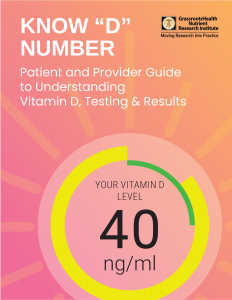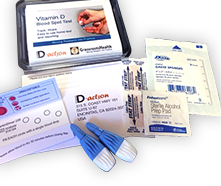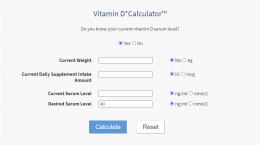Published on December 16, 2022
Many of us can easily become vitamin D deprived, especially during the winter… here’s how you can prevent it from happening and leading to long-term side effects of vitamin D deficiency

A recent article in Sioux Falls Woman Magazine featured GrassrootsHealth’s founder Carole Baggerly. Its focus: how easily many of us become vitamin D deprived during the winter, and how to prevent it from happening and leading to long-term side effects that can result from vitamin D deficiency.
Almost 90% of adults and more than 90% of children in the United States are below a vitamin D level of 40-60 ng/ml (100-150 nmol/L)! The issue of vitamin D deficiency is at its worst during the winter months.
How Can We Prevent this from Becoming a Problem?
“The best way to combat vitamin D deficiency is by educating yourself, testing serum levels, adjusting behaviors such as sun exposure, and finding a good supplement source!” Luckily, GrassrootsHealth has just the tools to help you do this.
What is your risk of being “deprived” of vitamin D?
To educate everyone about their unique, individual risk factors for vitamin D deficiency and to highlight when testing may be of extra importance, we have created The Vitamin D Deficiency Risk Assessment Quiz (Beta), a short set of questions about an individual’s supplemental vitamin D intake, UVB exposure, and low exposure indicators to assess risk level. Scoring is intended to determine if an individual has a low, moderate, or high risk of having a vitamin D level below 40 ng/ml (100 nmol/L).
To help further validation of this e-Tool, individuals who complete the quiz will receive a coupon for $5 off their next kit order, and will be encouraged to complete their questionnaire and vitamin D test within a month of completing the quiz. This coupon can be combined with any other offer.
Find out your risk of having a low vitamin D level.
* This quiz and scoring tool are currently in beta mode
Take the Quiz Now for Your $5 Coupon
What can you do to optimize your vitamin D levels?
 The IRB-approved KNOW “D” NUMBER Patient and Provider Guide to Understanding Vitamin D, Testing & Results booklet was created by a team of vitamin D experts to help patients and health care providers alike better understand vitamin D and the importance of knowing the vitamin D level.
The IRB-approved KNOW “D” NUMBER Patient and Provider Guide to Understanding Vitamin D, Testing & Results booklet was created by a team of vitamin D experts to help patients and health care providers alike better understand vitamin D and the importance of knowing the vitamin D level.
Everyone needs vitamin D, and while each person is unique in how they get it and how they respond to intake, the information in this guide can help ALL achieve the vitamin D level they want for their own health!
Download, read and share this practical guide on how anyone can achieve and maintain their target vitamin D level.
How much vitamin D might you need?
 Use the Vitamin D*calculator to calculate the estimated Vitamin D intake needed to reach your target vitamin D serum level (40-60 ng/ml recommended by our scientist panel). The calculator is best used when a current/starting vitamin D level is known.
Use the Vitamin D*calculator to calculate the estimated Vitamin D intake needed to reach your target vitamin D serum level (40-60 ng/ml recommended by our scientist panel). The calculator is best used when a current/starting vitamin D level is known.
Go to the Vitamin D*calculator™
Why do we need vitamin D?
Every tissue in our bodies needs vitamin D and may be impaired if we do not get enough. In its most extreme forms, vitamin D deficiency results in rickets in children and osteomalacia (bone softening) in adults. Milder degrees of deficiency are being studied as risk factors of a vast array of chronic diseases, including osteoporosis, impaired cognitive and immune function, various autoimmune diseases (such as diabetes and multiple sclerosis), several cancers (such as breast, colon, lung, lymphoma, and prostate), high blood pressure, pregnancy complications, and cardiovascular disease.

Vitamin D deficiency may also be linked to:
Brain
Depression & Anxiety Schizophrenia, Alzheimer’s Disease, ADHD & Autism
Circulatory
High Blood Pressure, Peripheral Artery Disease, Coronary Heart Disease, Atrial Fibrillation
Respiratory
Colds & Flu, Pneumonia & Acute Respiratory Distress Syndrome (ARDS), Asthma, Tuberculosis
Muscle
Neuromuscular Pain, Weakness, Injury
Bone
Rickets, Osteoporosis Fracture
Auto-Immune
Diabetes, Crohn’s Disease, Cancer, Multiple Sclerosis, Psoriasis
Reproductive
Infertility, Preterm Birth & Prenatal Complications
And MORE!
People who have current vitamin D deficiency may not have any symptoms or may experience any of the following symptoms:
- Lack of focus
- Dizziness
- Frequent infections
- Exhaustion
- Weakness
- Headaches
- Body pain
- Depression
- Anxiety
How can you know for sure if you are getting enough vitamin D?
 The only way to know is to measure the vitamin D level. The total 25(OH)D level is the accepted measure used to determine the current/baseline vitamin D status. Measuring vitamin D is the only way to know if an individual is getting enough and how much supplementation may be needed!
The only way to know is to measure the vitamin D level. The total 25(OH)D level is the accepted measure used to determine the current/baseline vitamin D status. Measuring vitamin D is the only way to know if an individual is getting enough and how much supplementation may be needed!






